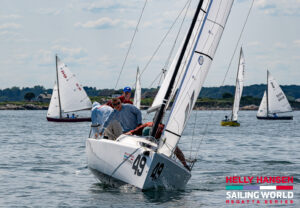In Southern California, colder sea surface temperatures resulting from the south-going California current help maintain an ever-present marine layer, which reinforces the stability of the lower 2000ft. Therefore, synoptic (large scale) winds and events typically play less of a role in the weather of this region, allowing the sea breeze and localized winds to dominate.To predict the wind in San Diego, one needs to constantly ask, “How will the synoptic winds affect the sea breeze and localized winds”In March, weather events like cold fronts and coastal storms typically migrate further north allowing the North Pacific High to establish itself and the daily sea breeze cycle to kick in. However, March can still see the occasional short wave sneaking under the ridge to offer a variation. Such was the case in the 2006 San Diego NOOD, where Day 1 and Day 2 were significantly in terms of wind (see graphs). Day 1 was dominated by high pressure offshore and a weak ridge of high pressure inland that kept the sea breeze very weak. Note how the morning winds started as a weak land breeze (offshore) then veered completely around through the day to the normal south and southwest sea breeze. The wind never built to more than 6-8 knots. In stark contrast, after a weak short wave passed the coast line and moved inland over night, Day 2 started with a gusty and cool northwest wind. The short wave displaced the inland ridge and allowed the cooler and stronger northwest flow into the San Diego area. Note the more turbulent flow in the graphs as the gust and lull lines spread out- typical of a cool and heavily mixed flow. Day 3 saw a return of the inland ridge but not as strong as Day 1, thus the region went back to the southerly veering sea breeze. With a bit more sunshine and pressure drops inland, the sea breeze was able to come on very strong and consistent.San Diego is a tricky place to predict winds. One should always be wary of the large scale and upper level patterns, and how those patterns will affect the sea breeze balance.To aid in predictions and verifications Sailflow.com installed a weather station on the end of Zuniga Jetty. It was quite a difficult installation (ask our engineer whose ears are still ringing from working so close to the warning horn) but the site has proved invaluable by providing real time information from a location so close to the racing courses.Sailflow.com provides real-time sensors as well as forecast products complimentary through the race period at www.sailflow.com/sandiego. Also, in cooperation with North Sails, Sailing Weather Service is offering free precision race forecasts for this event. Sign up here.









